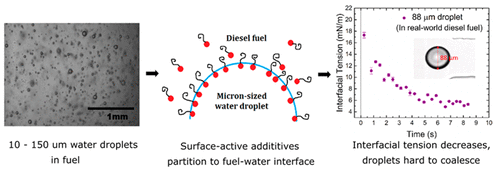当前位置:
X-MOL 学术
›
Energy Fuels
›
论文详情
Our official English website, www.x-mol.net, welcomes your
feedback! (Note: you will need to create a separate account there.)
Removing Water from Diesel Fuel: Understanding the Impact of Droplet Size on Dynamic Interfacial Tension of Water-in-Fuel Emulsions
Energy & Fuels ( IF 5.2 ) Pub Date : 2018-05-25 00:00:00 , DOI: 10.1021/acs.energyfuels.8b00502 Shweta Narayan 1 , Davis B. Moravec 2 , Brad G. Hauser 2 , Andrew J. Dallas 2 , Cari S. Dutcher 1
Energy & Fuels ( IF 5.2 ) Pub Date : 2018-05-25 00:00:00 , DOI: 10.1021/acs.energyfuels.8b00502 Shweta Narayan 1 , Davis B. Moravec 2 , Brad G. Hauser 2 , Andrew J. Dallas 2 , Cari S. Dutcher 1
Affiliation

|
Small amounts of water can enter diesel fuel during usage, causing major damage and failure of engine parts. Water is dispersed in fuel as droplets stabilized by the presence of surface-active compounds in the original fuel mixture as well as in fuel additives, including lubricity improvers and deposit control agents. Additives partition to the fuel–water interface and lower the interfacial tension (IFT), decreasing the ability to coalesce and separate water from fuel. The ability of standard coalescing filters to capture and coalesce emulsion droplets depends on dynamic IFT, conventionally measured for large millimeter-sized drops or planar interfaces. In this work, a microfluidic platform is employed to generate a monodisperse stream of small micrometer-sized water droplets in model fuel and ultralow sulfur diesel, mimicking the size of droplets in actual fuel–water emulsions. The deformation of hundreds of droplets is tracked at high speed through twenty-six geometric contractions to find time-dependent apparent IFT. It is found that the time scale associated with the decrease of IFT is orders of magnitude smaller in micrometer-sized droplets compared to millimeter-sized drops from pendant drop experiments. This finding suggests that, in real emulsion processing conditions such as fuel filtration, the residence time of droplets from the point of formation to filtration is such that IFT has already decreased to the equilibrium value. This work results in clear implications that standardized tests used by industry for qualifying diesel fuels must be reconsidered to account for droplet size, to enable design of efficient fuel filtration systems.
中文翻译:

从柴油中去除水:了解液滴大小对油包水型乳液动态界面张力的影响
在使用过程中,少量的水会进入柴油中,从而导致严重的损坏和发动机零件的故障。水被液滴分散在燃料中,液滴被原始燃料混合物中的表面活性化合物以及燃料添加剂(包括润滑性改进剂和沉积物控制剂)中的稳定化所稳定。添加剂分配到燃料-水界面并降低界面张力(IFT),从而降低了将水与燃料结合和分离的能力。标准聚结过滤器捕获和聚结乳剂液滴的能力取决于动态IFT,动态IFT通常是针对大毫米大小的液滴或平面界面进行测量的。在这项工作中,使用微流体平台在模型燃料和超低硫柴油中产生了微米级小水滴的单分散流,模仿实际的燃料-水乳液中的液滴大小。通过二十六个几何收缩来高速跟踪数百个液滴的变形,以发现随时间变化的视在IFT。已经发现,与来自悬滴实验的毫米大小的液滴相比,微米大小的液滴中与IFT降低相关的时间尺度要小几个数量级。该发现表明,在诸如燃料过滤的实际乳液加工条件下,液滴从形成点到过滤的停留时间使得IFT已经降低至平衡值。这项工作产生了明确的含义,必须重新考虑行业用于鉴定柴油燃料的标准化测试,以考虑液滴尺寸,从而能够设计出有效的燃料过滤系统。
更新日期:2018-05-25
中文翻译:

从柴油中去除水:了解液滴大小对油包水型乳液动态界面张力的影响
在使用过程中,少量的水会进入柴油中,从而导致严重的损坏和发动机零件的故障。水被液滴分散在燃料中,液滴被原始燃料混合物中的表面活性化合物以及燃料添加剂(包括润滑性改进剂和沉积物控制剂)中的稳定化所稳定。添加剂分配到燃料-水界面并降低界面张力(IFT),从而降低了将水与燃料结合和分离的能力。标准聚结过滤器捕获和聚结乳剂液滴的能力取决于动态IFT,动态IFT通常是针对大毫米大小的液滴或平面界面进行测量的。在这项工作中,使用微流体平台在模型燃料和超低硫柴油中产生了微米级小水滴的单分散流,模仿实际的燃料-水乳液中的液滴大小。通过二十六个几何收缩来高速跟踪数百个液滴的变形,以发现随时间变化的视在IFT。已经发现,与来自悬滴实验的毫米大小的液滴相比,微米大小的液滴中与IFT降低相关的时间尺度要小几个数量级。该发现表明,在诸如燃料过滤的实际乳液加工条件下,液滴从形成点到过滤的停留时间使得IFT已经降低至平衡值。这项工作产生了明确的含义,必须重新考虑行业用于鉴定柴油燃料的标准化测试,以考虑液滴尺寸,从而能够设计出有效的燃料过滤系统。











































 京公网安备 11010802027423号
京公网安备 11010802027423号